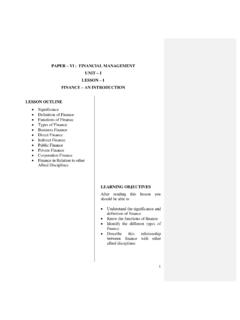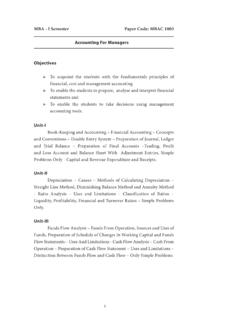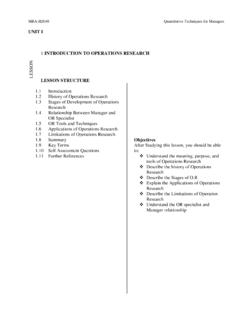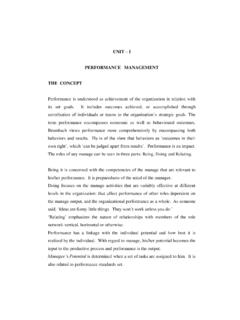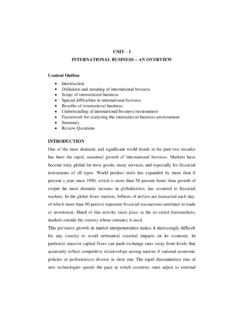Transcription of LESSON 1 Concept of Corporate Strategy
1 Unit I 1 concept of corporate strategy LESSON OUTLINE Introduction What is Strategy ? Why Corporate Strategy ? Levels of Strategy Crafting a Strategy An ongoing process Summary Self assessment questions Activities References LEARNING OBJECTIVES After reading this LESSON you should be able to Define and understand the Concept of Corporate Strategy Identify the different levels of Corporate Strategy Examine the reasons for developing strategies See Corporate Strategy as an on going process LESSON Organizations are facing exciting and dynamic challenges in the 21st century. In the gloabalized business, companies require strategic thinking and only by evolving good Corporate strategies can they become strategically competitive.
2 A sustained or sustainable competitive advantage occurs when firm implements a value creating Strategy of which other companies are unable to duplicate the benefits or find it too costly to initiate. Corporate Strategy includes the commitments, decisions and actions required for a firm to achieve strategic competitiveness and earn above average returns. The goals of Corporate Strategy are challenging not only for large firms like Microsoft but also for small local computer retail outlets or even dry cleaners. Table lists the top ten strategists in India in TABLE - INDIA S TOP TEN STRATEGISTS Name of the company Position in the industry Infosys Technologies 1 Reliance Industries 2 Wipro 3 Hindustan Lever 4 Maruti Udyog 5 Dr. Reddy s Laboratories 6 HDFC Bank 7 Jet Airways 8 ICICI Bank 9 Ranbaxy Laboratories 10 * Source - Internet What is Strategy ?
3 Strategy , narrowly defined, means the art of the general (the Greek stratos, meaning field, spread out as in structure ; and agos, meaning leader ). The term first gained currency at the end of the 18th century, and had to do with stratagems by which a general sought to deceive an enemy, with plans the general made for a campaign, and with the way the general moved and disposed his forces in war. Also was the first to focus on the fact that Strategy of war was a means to enforce policy and not an end in itself. Strategy is a set of key decisions made to meet objectives. A Strategy of a business organization is a comprehensive master plan stating how the organization will achieve its mission and objectives. Here are some definitions of Strategy . Chandler(1962) Strategy is the determinator of the basic long-term goals of an enterprise, and the adoption of courses of action and the allocation of resources necessary for carrying out these goals; Mintzberg (1979) Strategy is a mediating force between the organization and its environment: consistent patterns in streams of organizational decisions to deal with the environment.
4 Prahlad (1993) Strategy is more then just fit and allocation of resources. It is stretch and leveraging of resources Porter (1996) Strategy is about being different. It means deliberately choosing a different set of activities to deliver a unique mix of value I keep six honest serving men. They taught me all I know. Their names are What, Why, When, How, Where and Who. - Rudyard Kipling Mintzberg has identified the 5 P s of Strategy . Strategy could be a plan, a pattern, a position, a ploy, or a perspective. 1. A plan, a how do I get there 2. A pattern, in consistent actions over time 3. A position that is, it reflects the decision of the firm to offer particular products or services in particular markets. 4. A ploy, a maneuver intended to outwit a competitor 5.
5 A perspective that is, a vision and direction, a view of what the company or organization is to become. Why Corporate Strategy ? Strategic management is basically needed for every organization and it offers several benefits. Strategy refers to a complex web of thoughts, ideas, insights, experiences, goals, expertise, memories, perceptions, and expectations that provides general guidance for specific actions in pursuit of particular ends. Nations have, in the management of their national policies, found it necessary to evolve strategies that adjust and correlate political, economic, technological, and psychological factors, along with military elements. Be it management of national polices, international relations, or even of a game on the playfield, it provides us with the preferred path that we should take for the journey that we actually make.
6 2. Keeping pace with changing environment The present day environment is so dynamic and fast changing thus making it very difficult for any modern business enterprise to operate. Because of uncertainties, threats and constraints, the business corporation are under great pressure and are trying to find out the ways and means for their healthy survival. Under such circumstances, the only last resort is to make the best use of strategic management which can help the Corporate management to explore the possible opportunities and at the same time to achieve an optimum level of efficiency by minimizing the expected threats. 3. Minimizes competitive disadvantage It minimizes competitive disadvantage and adds up to competitive advantage. For example, a company like Hindustan Lever Ltd., realized that merely by merging with companies like Lakme, Milk food, Ponds, Brooke bond, Lipton etc which make fast moving consumer goods alone will not make it market leader but venturing into retailing will help it reap heavy profits.
7 Then emerged its retail giant Margin Free which is the market leader in states like Kerala. Similarly, the Goenka Group and the Muruguppa group realized that mere takeovers do not help and there is a need to reposition their products and reengineer their brands. The Strategy worked. 4. Clear sense of strategic vision and sharper focus on goals and objectives Every firm competing in an industry has a Strategy , because Strategy refers to how a given objective will be achieved. Strategy defines what it is we want to achieve and charts our course in the market place; it is the basis for the establishment of a business firm; and it is a basic requirement for a firm to survive and to sustain itself in today s changing environment by providing vision and encouraging to define mission.
8 Employees One should note that the labor efficiency and loyalty towards management can be expected only in an organization that operates under strategic management. Every guidance as to what to do, when and how to do and by whom etc, is given to every employee. This makes them more confident and free to perform their tasks without any hesitation. Labor efficiency and their loyalty which results into industrial peace and good returns are the results of broad-based policies adopted by the strategic management 6. Strengthening Decision-Making Under strategic management, the first step to be taken is to identify the objectives of the business concern. Hence a corporation organized under the basic principles of strategic management will find a smooth sailing due to effective decision-making.
9 This points out the need for strategic management. 7. Efficient and effective way of implementing actions for results Strategy provides a clear understanding of purpose, objectives and standards of performance to employees at all levels and in all functional areas. Thereby it makes implementation very smooth allowing for maximum harmony and synchrony. As a result, the expected results are obtained more efficiently and economically. 8. Improved understanding of internal and external environments of business Strategy formulation requires continuous observation and understanding of environmental variables and classifying them as opportunities and threats. It also involves knowing whether the threats are serious or casual and opportunities are worthy or marginal.
10 As such Strategy provides for a better understanding of environment. Levels of Strategy A typical business firm should consider three types of strategies, which form a hierarchy as shown in Figure Corporate Strategy Which describes a company s overall direction towards growth by managing business and product lines? These include stability, growth and retrenchment. For example, Coco cola, Inc., has followed the growth Strategy by acquisition. It has acquired local bottling units to emerge as the market leader. Business Strategy - Usually occurs at business unit or product level emphasizing the improvement of competitive position of a firm s products or services in an industry or market segment served by that business unit. Business Strategy falls in the in the realm of Corporate Strategy .



